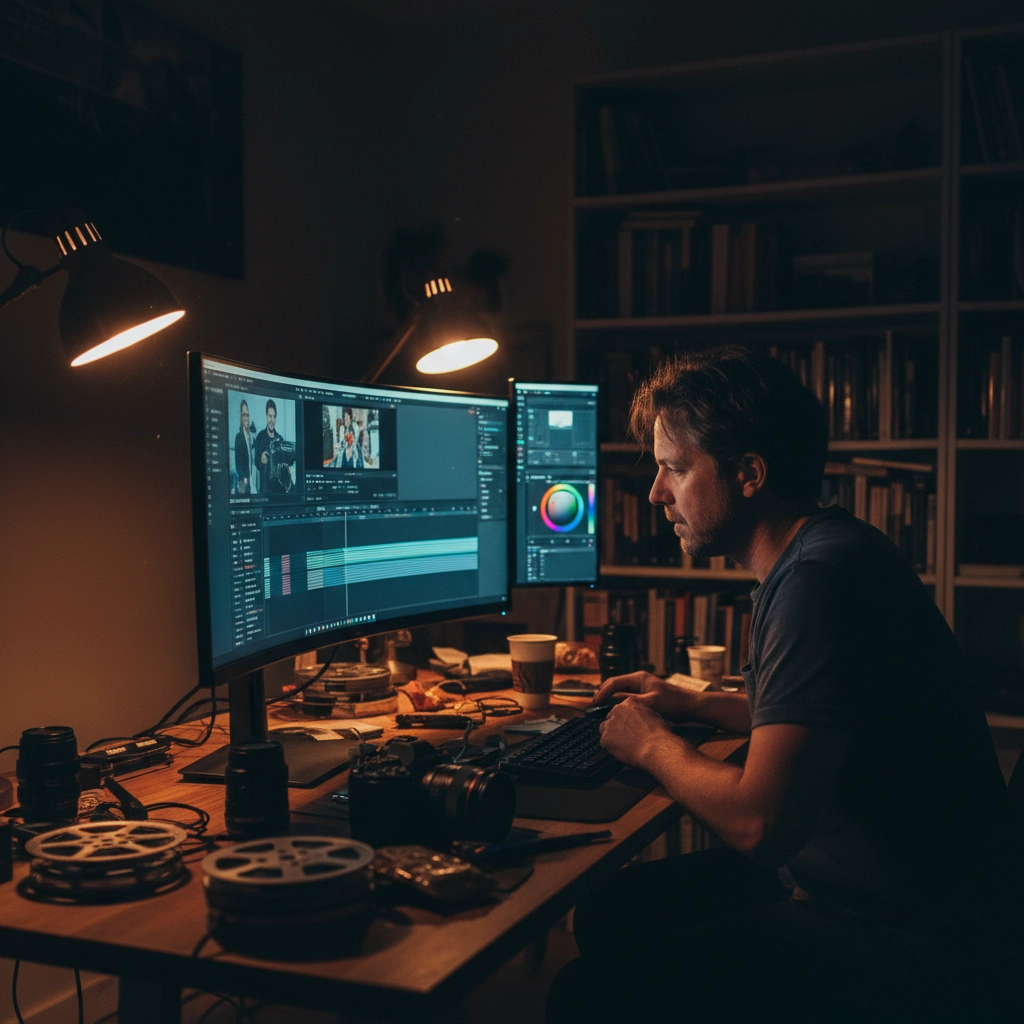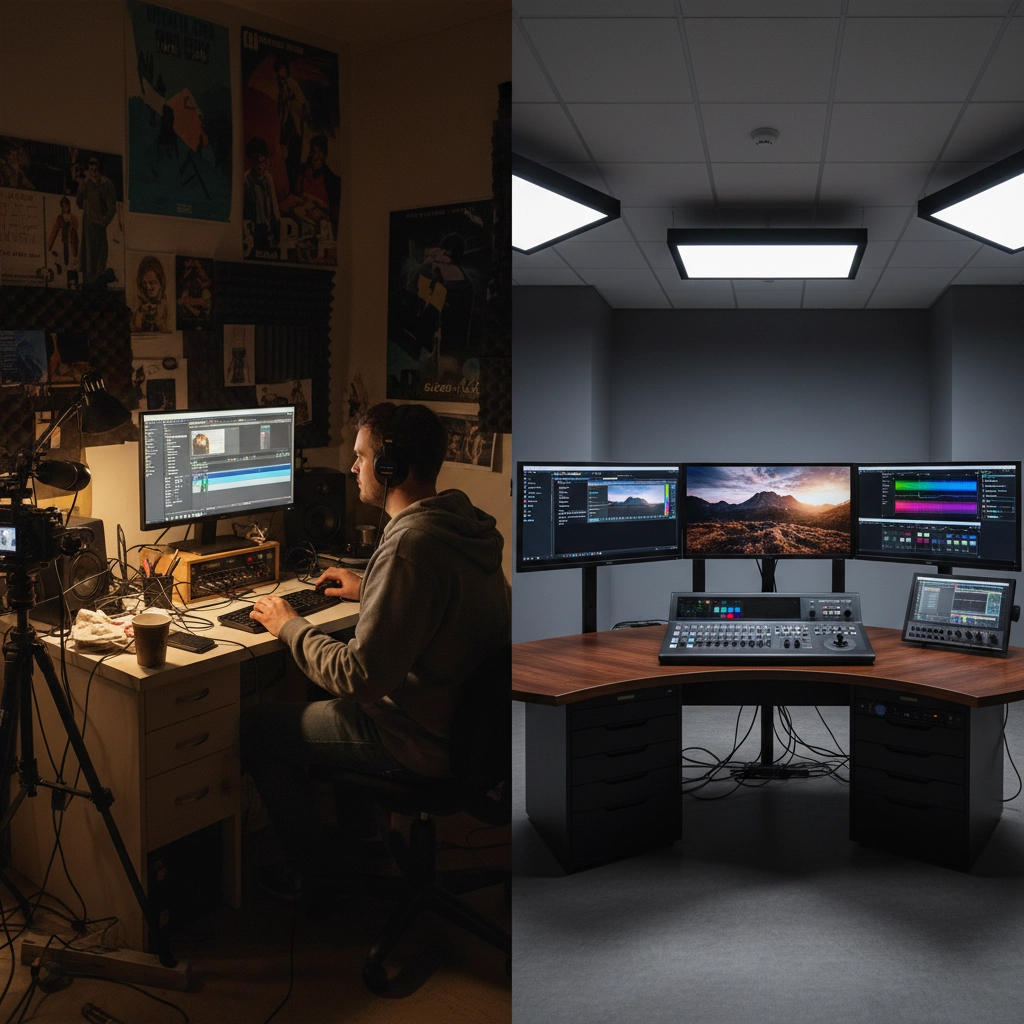Remote Post-Production vs In-House Studios: Which Is Better for Your Independent Film?
Independent filmmakers face a critical decision that can make or break their project's success and budget: should you handle post-production remotely through specialised services, or build your own in-house studio capabilities?
This choice carries more weight for indie productions than studio-backed films. While major studios operate with robust teams and daily cost reports, independent films typically lack structured oversight and work with severely constrained resources. Every dollar counts. Every decision compounds.
The post-production phase consumes 30-40% of most film budgets. Get this wrong, and you'll either compromise your vision or exhaust your funding before reaching distribution.
Remote Post-Production: Access Without Ownership
Remote post-production services provide immediate access to professional-grade expertise and equipment without the overhead burden of maintaining staff and infrastructure during project gaps.
Core Advantages
Professional remote services deliver specialised skills across colour grading, sound design, visual effects, and advanced editing techniques that small in-house teams rarely possess. You're hiring years of experience across diverse projects, not just technical proficiency.
Cost structure favours variable workloads. Avoid paying salaries during downtime periods between projects. Eliminate equipment purchases: professional editing workstations, colour grading suites, and specialised software licenses easily exceed $50,000 for a basic setup.
Remote partners bring unbiased outside perspective. They catch issues invisible to someone embedded in footage for months. Fresh eyes identify pacing problems, continuity errors, and creative opportunities that tunnel vision obscures.
Scalability comes standard. Complex sequences requiring additional resources don't permanently increase overhead. Scale up for demanding projects, scale down for simple ones.

Implementation Challenges
Communication barriers create the primary risk. Remote collaboration demands crystal-clear articulation of creative vision. Miscommunications cause delays and deliverables that miss the mark.
External dependency introduces scheduling constraints. Your project competes for attention with other clients. Urgent changes wait for availability windows.
Upfront costs exceed DIY approaches, though quality and efficiency gains typically justify the investment. For bootstrap-accustomed indie filmmakers, professional service fees feel substantial even when delivering superior results.
In-House Studios: Control and Intimacy
Building internal post-production capabilities provides complete creative control and intimate project knowledge at every production stage.
Strategic Benefits
Unmatched flexibility for revisions and creative pivots. Same-day changes happen without negotiating schedules or additional fees. Your team responds instantly to artistic adjustments.
Long-term economics favour in-house production once initial equipment costs are absorbed. Per-project expenses decrease significantly over multiple productions.
Institutional knowledge accumulates. Your team learns your filmmaking style, technical workflows, and archival systems. This expertise streamlines future projects and eliminates repeated learning curves.
Direct resource allocation prevents unexpected budget overruns from external vendors. You control every expenditure and timeline decision.

Resource Constraints
Capital investment requirements hit independent budgets hardest. Professional editing software, color grading tools, sound design equipment, and capable workstations demand substantial upfront funding that smaller productions struggle to justify.
Expertise gaps limit capabilities unless your team consists of dedicated post-production specialists. Most indie crews lack the depth of knowledge found at professional facilities.
Opportunity costs compound when limited crew members divert attention from other critical tasks. Independent films operate with lean teams wearing multiple hats. Dedicating personnel to post-production reduces capacity for development, production, and distribution activities.
Creative burnout emerges from extended single-project focus. Team members working exclusively on the same material for months experience stagnant thinking and diminished innovation motivation.
The Economics of Choice
Remote services charge per project, typically ranging from $5,000-$25,000 for feature-length independent films depending on complexity and turnaround requirements. This includes professional-grade equipment access and specialized expertise.
In-house setups require $30,000-$100,000 initial investment for basic professional capabilities. Add ongoing software licenses, equipment maintenance, and staff salaries during production gaps.
Break-even analysis depends on production frequency. Remote services favor occasional projects or first-time filmmakers. In-house infrastructure benefits producers creating multiple films annually.

Technical Considerations
Remote post-production facilities offer enterprise-grade hardware and software that independent budgets rarely afford. High-end color grading suites, surround sound mixing rooms, and render farms provide technical capabilities impossible to replicate affordably in-house.
Data transfer and collaboration tools have eliminated many traditional remote work barriers. Cloud-based review platforms, real-time editing access, and high-speed file sharing enable effective remote collaboration.
In-house limitations often force creative compromises. Budget constraints typically result in consumer or prosumer equipment that limits colour depth, audio quality, and rendering speed.
Quality differences become apparent in final deliverables. Professional facilities produce technically superior results that enhance festival acceptance rates and distribution opportunities.
Workflow Implications
Remote partnerships require structured communication protocols. Detailed creative briefs, reference materials, and approval processes prevent miscommunications and revision cycles.
In-house production allows organic creative evolution. Ideas develop naturally through constant access and informal collaboration. This flexibility benefits experimental or evolving projects.
Project handoff complexity varies significantly. Remote services demand organised asset delivery and clear specifications. In-house workflows develop organically around team preferences and capabilities.

Decision Framework
Choose remote post-production when:
- Producing first or second independent film without established infrastructure
- Project requires specialised skills (advanced VFX, complex sound design, high-end colour grading)
- Extremely tight budget cannot support equipment and full-time staff
- Significant gaps exist between productions
- Professional finish is essential for festival competition or distributor attraction
Choose in-house production when:
- Multiple annual projects justify equipment and staff costs
- Team possesses strong existing post-production skills
- Quick iteration matters more than technical perfection
- Equipment and software investments already exist
- Authentic, unpolished aesthetics enhance storytelling
- Organisational structure prevents indie production inefficiencies
Hybrid Solutions
Most successful independent filmmakers adopt mixed approaches. Handle basic editing and assembly in-house to maintain creative control during rough cut phases. Outsource specialised work: colour correction, sound mixing, visual effects: where professional expertise delivers maximum value.
This strategy preserves budget while ensuring technical excellence in areas where audiences notice quality differences most acutely. You maintain creative ownership while accessing professional capabilities for critical finishing work.
Services like remote offline hire and hybrid enable this hybrid approach, providing access without full facility commitments.
The decision isn't permanent. Start with remote services to establish quality standards and learn professional workflows. Gradually build in-house capabilities as production volume and budget allow.
Independent filmmaking success depends on maximising limited resources while maintaining creative vision. Whether remote or in-house, choose the post-production approach that serves your story, not your ego.
